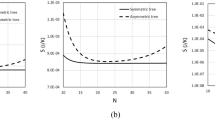Abstract
An optimization model is described for lung and vascular tree structures. The model extends Murray's model, which is derived from minimal power dissipation due to the frictional resistance of laminar flow and the volume of the duct system. Instead of just laminar flow, it takes into account all types of steady flow, e.g. turbulent and laminar flow, and predicts which structural changes will occur among different parts of trees having different types of flow. The sensitivity of the optimal values is indicated and the model, predictions are compared with literature data.
Similar content being viewed by others
Literature
Horsfield, K. and G. Cumming. 1967. “Angles of Branching and Diameters of Branches in the Human Bronchial Tree.”Bull. Math. Biophys.,29, 245–259.
Hunt, W. A. 1969. “Calculations of Pulsatile Flow across Bifurcations in Distensible Tubes.”Biophys. J.,9, 993–1005.
Kamiya, A., T. Togawa and A. Yamamoto. 1974. “Theoretical Relationship between the Optimal Models of the Vascular Tree.”Bull. Math. Biol.,36, 311–323.
Karreman, G. 1952. “Some Contributions to the Mathematical Biology of Blood Circulation. Reflections of Pressure Waves in the Arterial System.”Bull. Math. Biophys.,14, 327–350.
McDonald, D. A. 1960.Blood Flow in Arteries. London: Arnold Ltd.
Milsum, J. H. and F. A. Roberge. 1973. “Physiological Regulation and Control.” InFoundations of Mathematical Biology, Vol. III, Ed. R. Rosen, pp. 63–95. New York: Academic Press.
Moody, L. F. 1944. “Friction Factors for Pipe Flow.”Trans. ASME,66, 671–684.
Murray, C. D. 1926a. “The Physiological Principle of Minimum Work, I.”Proc. Nat. Acad. Sci.,12, 207–214.
—. 1926b. “The Physiological Principle of Minimum Work applied to the Angle of Branching of Arteries.”J. Gen. Physiol.,9, 835–841.
Newman, D. L., R. G. Gosling and N. L. R. Bowden. 1971. “Changes in Aortic Distensibility and Area Ratio with the Development of Atherosclerosis.”Atherosclerosis,14, 231–240.
Olson, D. E., G. A. Dart and G. F. Filley. 1974. “Pressure Drop and Fluid Flow Regime of Air inspired into the Human Lung.”J. Appl. Physiol.,28, 482–494.
Rashevsky, N. 1973, “The Principle of Adequate Design.” InFourndations of Mathematical Biology, Vol. III, Ed. R. Rosen, pp. 143–175. New York: Academic Press.
Rosen, R. 1967.Optimality Principles in Biology. London: Butterworths.
— 1970.Dynamic System Theory in Biology, I: Stability Theory and its Applications. New York: Wiley.
Steenbrink, P. A. 1974.Optimization of Transport Networks. London: Wiley—Interscience.
Stein, P. D. and H. N. Sabbah. 1976. “Turbulent, Blood Flow in the Ascending, Aorta of Humans with Normal and Diseased Aortic Valves.”Circ. Res.,39, 58–65.
Thoma, R. 1922. “Die mittlere Durchflussmenge der Arterien des Menschen als Funktion des Gefässradius, II”Pflüger Arch. ges. Physiol.,194, 385–406.
Thompson, D'Arcy, W. 1966.On Growth and Form. Abridged Edition. Cambridge: University Press.
Uylings, H. B. M. and W. A. M. Veltman. 1975. “Characterizing a Dendritic Bifurcation.”Neurosci. Lett.,1, 127–128.
Zamir, M. 1975. “The Role of Shear Forces in Arterial Branching.”J. Gen. Physiol.,67, 213–222.
Author information
Authors and Affiliations
Rights and permissions
About this article
Cite this article
Uylings, H.B.M. Optimization of diameters and bifurcation angles in lung and vascular tree structures. Bltn Mathcal Biology 39, 509–520 (1977). https://doi.org/10.1007/BF02461198
Received:
Revised:
Issue Date:
DOI: https://doi.org/10.1007/BF02461198




